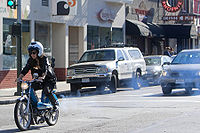Two stroke

A Two stroke engine differs from the four stroke engine by completing the four strokes of intake, compression, combustion, exhaust in only two strokes of the piston rather than four. This is done by using the beginning of the compression stroke and the end of the combustion stroke to perform the intake and exhaust functions. This allows a power stroke for every revolution of the crank, instead of every second revolution as in a four stroke engine.
Two stroke engines provide high specific power for lightweight motorcycles as well as chainsaws. An example of a large application is locomotive engines of the 1800-1900s. Most designs use total-loss lubrication, with the oil being burnt in the combustion chamber, causing "blue smoke" and other types of exhaust pollution. This is the major reason for two-stroke engines being replaced with four-stroke engines in most applications.
Dugald Clark is attributed with inventing the two stroke cycle around 1880. His engines had a separate charging cylinder. Joseph Day is credited with the "crank case" scavenged engine using the area below the piston as a charging pump. Frederick Cock is credited for the piston controlled inlet port engine.
Different two-stroke design types[edit | edit source]

Although the principles remain the same, the mechanical details of various two-stroke engines differ depending on the type. The design types of the two-stroke engine vary according to the method of introducing the charge to the cylinder, the method of scavenging the cylinder (exchanging burnt exhaust for fresh mixture) and the method of exhausting the cylinder.
Reed inlet valve[edit | edit source]
The reed valve is a simple but highly effective form of check valve commonly fitted in the intake tract of the piston-controlled port. They allow asymmetric intake of the fuel-charge, improving power and economy, while widening the power band. They are widely used in ATVs, and marine outboard engines.
Rotary inlet valve[edit | edit source]
The intake pathway is opened and closed by a rotating member. A familiar type sometimes seen on small motorcycles is a slotted disk attached to the crankshaft which covers and uncovers an opening in the end of the crankcase, allowing charge to enter during one portion of the cycle.
Another form of rotary inlet valve used on two-stroke engines employs two cylindrical members with suitable cutouts arranged to rotate one within the other - the inlet pipe having passage to the crankcase only when the two cutouts coincide. The crankshaft itself may form one of the members, as in most Glowplug model engines. In another embodiment, the crank disc is arranged to be a close-clearance fit in the crankcase and is provided with a cutout which lines up with an inlet passage in the crankcase wall at the appropriate time, as in the Vespa motor scooter.
The advantage of a rotary valve is that it enables the two-stroke engine's intake timing to be asymmetrical which is not possible with two-stroke piston port type engines. The two-stroke piston port type engine's intake timing opens and closes before and after top dead center at the same crank angle making it symmetrical whereas the rotary valve allows the opening to begin earlier and close earlier.
Rotary valve engines can be tailored to deliver power over a wider speed range or higher power over a narrower speed range than either piston port or reed valve engine. Where a portion of the rotary-valve is a portion of the crankcase itself it is particularly important that no wear is allowed to take place.
Crossflow-scavenged[edit | edit source]
In a crossflow engine the transfer ports and exhaust ports are on opposite sides of the cylinder and a deflector on the top of the piston directs the fresh intake charge into the upper part of the cylinder pushing the residual exhaust gas down the other side of the deflector and out of the exhaust port. The deflector increases piston's weight and its exposed surface area, and also makes it difficult to achieve an efficient combustion chamber shape. This design has been largely superseded by loop scavenging method (below), although for smaller or slower engines the crossflow-scavenged design can be an acceptable approach.